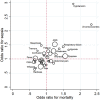The Presentation, Pace, and Profile of Infection and Sepsis Patients Hospitalized Through the Emergency Department: An Exploratory Analysis
- PMID: 33655214
- PMCID: PMC7909460
- DOI: 10.1097/CCE.0000000000000344
The Presentation, Pace, and Profile of Infection and Sepsis Patients Hospitalized Through the Emergency Department: An Exploratory Analysis
Abstract
To characterize the signs and symptoms of sepsis, compare them with those from simple infection and other emergent conditions and evaluate their association with hospital outcomes.
Design setting participants and intervention: A multicenter, retrospective cohort study of 408,377 patients hospitalized through the emergency department from 2012 to 2017 with sepsis, suspected infection, heart failure, or stroke. Infected patients were identified based on Sepsis-3 criteria, whereas noninfected patients were identified through diagnosis codes.
Measurements and main results: Signs and symptoms were identified within physician clinical documentation in the first 24 hours of hospitalization using natural language processing. The time of sign and symptom onset prior to presentation was quantified, and sign and symptom prevalence was assessed. Using multivariable logistic regression, the association of each sign and symptom with four outcomes was evaluated: sepsis versus suspected infection diagnosis, hospital mortality, ICU admission, and time of first antibiotics (> 3 vs ≤ 3 hr from presentation). A total of 10,825 signs and symptoms were identified in 6,148,348 clinical documentation fragments. The most common symptoms overall were as follows: dyspnea (35.2%), weakness (27.2%), altered mental status (24.3%), pain (23.9%), cough (19.7%), edema (17.8%), nausea (16.9%), hypertension (15.6%), fever (13.9%), and chest pain (12.1%). Compared with predominant signs and symptoms in heart failure and stroke, those present in infection were heterogeneous. Signs and symptoms indicative of neurologic dysfunction, significant respiratory conditions, and hypotension were strongly associated with sepsis diagnosis, hospital mortality, and intensive care. Fever, present in only a minority of patients, was associated with improved mortality (odds ratio, 0.67, 95% CI, 0.64-0.70; p < 0.001). For common symptoms, the peak time of symptom onset before sepsis was 2 days, except for altered mental status, which peaked at 1 day prior to presentation.
Conclusions: The clinical presentation of sepsis was heterogeneous and occurred with rapid onset prior to hospital presentation. These findings have important implications for improving public education, clinical treatment, and quality measures of sepsis care.
Keywords: electronic health record; infection; mortality; outcomes; sepsis.
Copyright © 2021 The Authors. Published by Wolters Kluwer Health, Inc. on behalf of the Society of Critical Care Medicine.
Conflict of interest statement
Dr. Liu’s and Dr. Escobar’s institution received funding from National Institutes of Health/National Institute for General Medical Sciences grant R35128672. Mr. Manickam disclosed work for hire. The remaining authors have disclosed that there are no potential conflicts of interest.
Figures




References
-
- Ferrer R, Martin-Loeches I, Phillips G, et al. . Empiric antibiotic treatment reduces mortality in severe sepsis and septic shock from the first hour: Results from a guideline-based performance improvement program. Crit Care Med. 2014; 42:1749–1755 - PubMed
Grants and funding
LinkOut - more resources
Full Text Sources
Other Literature Sources

